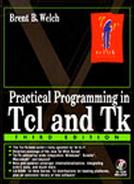Creating Interpreters
Here is a simple example that creates an interpreter, evaluates a couple of commands in it, and then deletes the interpreter:
Example 19-1 Creating and deleting an interpreter.
interp create foo => foo interp eval foo {set a 5} => 5 set sum [interp eval foo {expr $a + $a}] => 10 interp delete foo |
In Example 19-1 the interpreter is named foo. Two commands are evaluated in the foo interpreter:
set a 5 expr $a + $a
Note that curly braces are used to protect the commands from any interpretation by the main interpreter. The variable a is defined in the foo interpreter and does not conflict with variables in the main interpreter. The set of variables and procedures in each interpreter is completely independent.
The Interpreter Hierarchy
A slave interpreter can itself create interpreters, resulting in a hierarchy. The next examples illustrates this, and it shows how the grandparent of an interpreter can reference the grandchild by name. The example uses interp slaves to query the existence of child interpreters.
Example 19-2 Creating a hierarchy of interpreters.
The example creates foo, and then it creates two children of foo. The first one is created by foo with this command:
interp eval foo {interp create bar}
The second child is created by the main interpreter. In this case, the grandchild must be named by a two-element list to indicate that it is a child of a child. The same naming convention is used when the grandchild is deleted:
interp create {foo bar2}
interp delete {foo bar2}
The interp slaves operation returns the names of child (i.e., slave) interpreters. The names are relative to their parent, so the slaves of foo are reported simply as bar and bar2. The name for the current interpreter is the empty list, or {}. This is useful in command aliases and file sharing described later. For security reasons, it is not possible to name the master interpreter from within the slave.
The Interpreter Name as a Command
After interpreter slave is created, a new command is available in the main interpreter, also called slave, that operates on the child interpreter. The following two forms are equivalent most operations:
slave operation args ... interp operation slave args ...
For example, the following are equivalent commands:
foo eval {set a 5}
interp eval foo {set a 5}
And so are these:
foo issafe interp issafe foo
However, the operations delete, exists, share, slaves, target, and transfer cannot be used with the per interpreter command. In particular, there is no foo delete operation; you must use interp delete foo.
If you have a deep hierarchy of interpreters, the command corresponding to the slave is defined only in the parent. For example, if a master creates foo, and foo creates bar, then the master must operate on bar with the interp command. There is no “foo bar” command defined in the master.
Use list with interp eval
The interp eval command treats its arguments like eval. If there are extra arguments, they are all concatenated together first. This can lose important structure, as described in Chapter 10. To be safe, use list to construct your commands. For example, to safely define a variable in the slave, you should do this:
interp eval slave [list set var $value]
